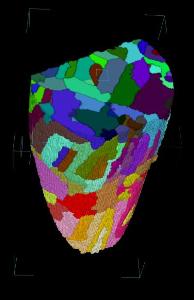Nov 24 2010
Every magnetic material is divided into such magnetic domains. Scientists call them "Weiss domains" after physicist Pierre-Ernest Weiss, who predicted their existence theoretically more than a hundred years ago.
In 1907, he recognized that the magnetic moments of atoms within a bounded domain are equally aligned.
 Boundaries of magnetic domains can be computer imaged in three dimensions.
Boundaries of magnetic domains can be computer imaged in three dimensions.
All pursuit of this theory has so far been limited to two-dimensional images and material surfaces. Accordingly, researchers have only ever been able to see a domain in cross section. Together with colleagues from the German Federal Institute for Materials Research and Testing and the Swiss Paul-Scherrer-Institute, Dr. Ingo Manke and his group at the Institute of Applied Material Research at HZB have developed a method by which they can image the full spatial structure of magnetic domains – even deep within materials. To do this, special iron-silicon crystals were produced at the Leibniz Institute for Solid State and Materials Research Dresden, for which the research group of Rudolf Schäfer had already developed model representations. Their actual existence has now been proven for the first time. With it, the researchers have solved a decade-old problem in imaging. Their findings will be published in Nature Communications (DOI: 10.1038 /ncomms1125).
Most magnetic materials consist of a complex network of magnetic domains. The researchers' newly developed method exploits the areas where the domains meet – the so-called domain walls. Within a domain, all magnetic moments are the same, but the magnetic alignment is different from one domain to another. So, at each domain wall, the direction of the magnetic field changes. The researchers exploit these changes for their radiographic method in which they use not light, but neutrons.
Magnetic fields deflect the neutrons slightly from their flight path, just as water diverts light. An object under water cannot be directly perceived because of this phenomenon; the object appears distorted and in a different location. Similarly, the neutrons pass through domain walls along their path through the magnetic material. At these walls, they are diverted into different directions.
This diversion, however, is only a very weak effect. It is typically invisible in a neutron radiogram, since it is overshadowed by non-diverted rays. The researchers therefore employ several diffraction gratings in order to separate the diverted rays. During a measurement, they rotate the sample and shoot rays through it from all directions. From the separated rays, they can calculate all domain shapes and generate an image of the domain network in its entirety.
Magnetic domains are important for understanding material properties and the natural laws of physics. They also play an important role in everyday life: most notably in storage media such as hard disks, for example, or battery chargers for laptops or electric vehicles. If the domain properties are carefully chosen to minimize electricity loss at the domain walls, the storage medium becomes more efficient.
Source: http://www.helmholtz.de/en/